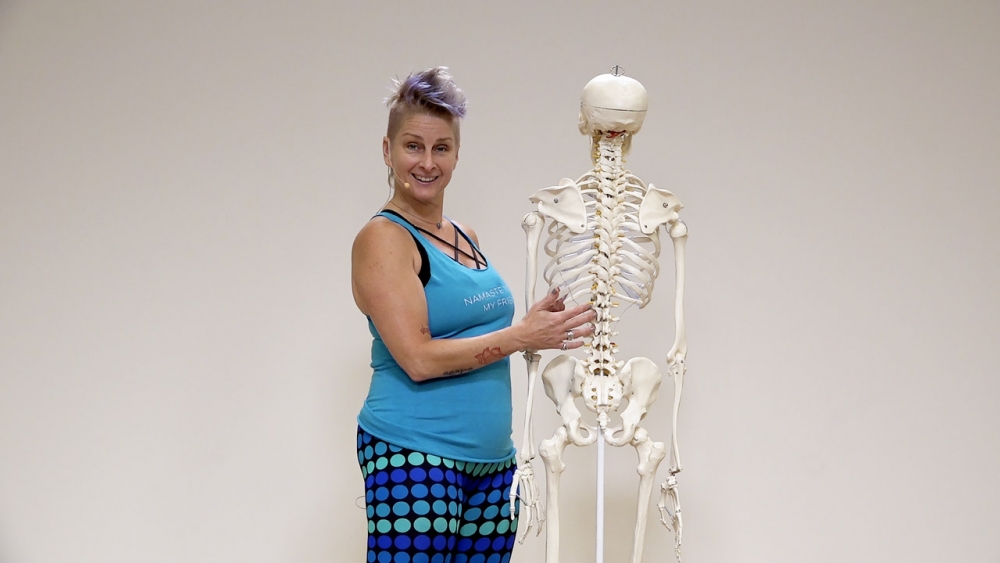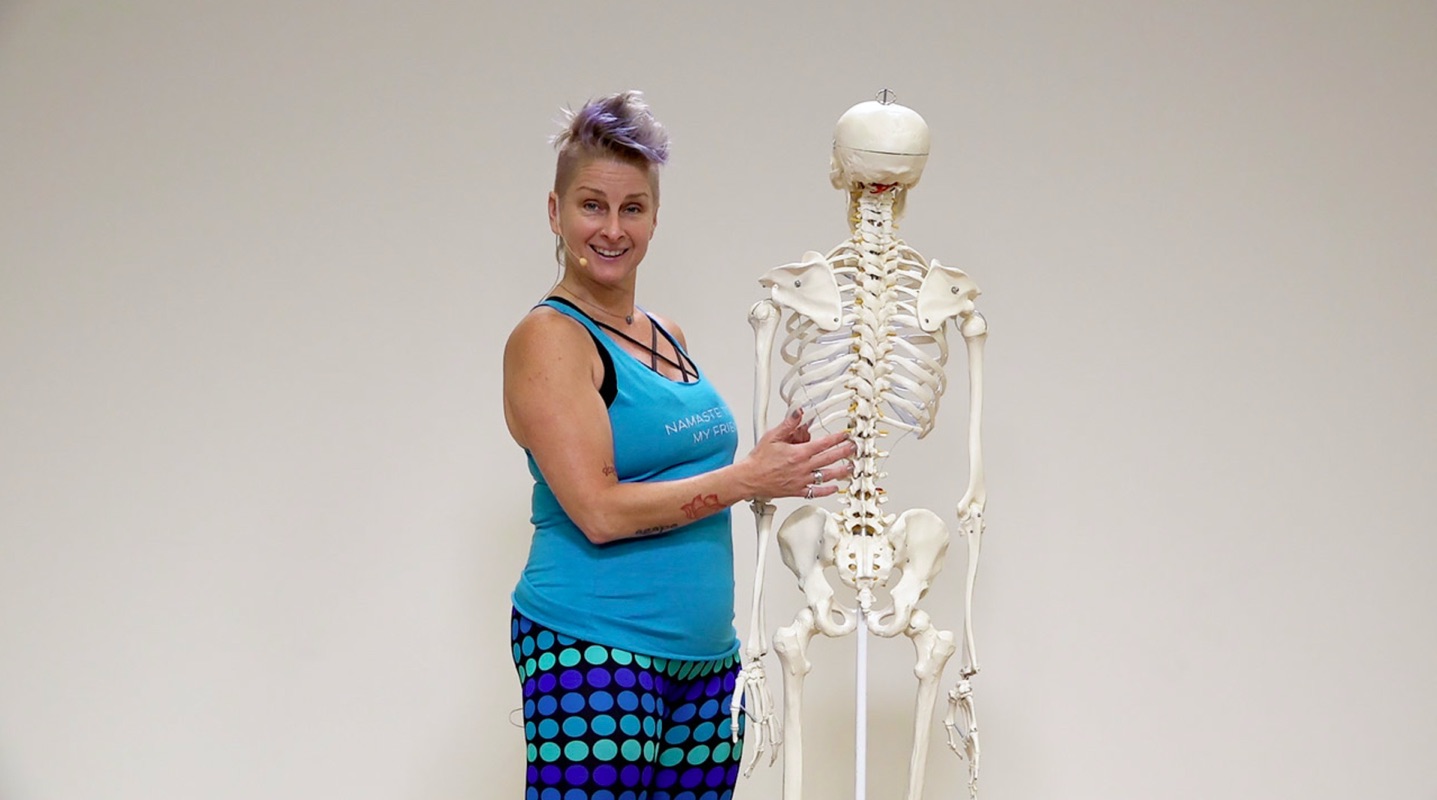What is the pelvis?
The pelvis is so much more than many of us think it is. There are the pelvic bones, the muscles attached to these bones, and the muscles of the pelvic floor. Then there are the deep stability muscles that pass through the pelvis and the organs that are situated in and around the pelvic area. So much to think about…so much to feel.
Bones of the pelvic bowl
We are born with 6 pelvic bones: two sides of the pubis (connected by thick connective tissue called pubis synthesis), two ilium bones and two ischium bones.
As we grow into adolescence the six bones fuse to create one pelvis, also referred to as pelvic girdle or pelvic bowl. This large, bony structure is part of the appendicular skeletal system and attaches to the axial skeletal system – skull, spine, sternum and ribs – via the sacrum. The sacrum comprises the 5 fused bones below the lumbar spine and above the coccyx/tailbone.
The female sacrum is usually shorter and wider than the male sacrum. Also, the female pelvic bones are usually larger and broader than the male’s. The female pelvis sits lower too; males have a taller pelvis with a higher iliac crest. This accounts for our (female’s) lower centre of gravity, our ability to support a growing life form and the tendency towards instability in our sacroiliac joints. In yoga, this lower pelvis can also account for the difficulty in lifting the pelvis over the shoulders in arm balances and inversions.
How tight hip muscles can affect pelvic freedom
When considering the muscles of the pelvis, most people focus on the muscles of the pelvic floor (see below). Rarely do we explore and gain a deeper understanding of all the muscles attached to the bones of the pelvis* and their important role in stabilisation, support and freedom – or adversely – tightness, weakness, instability, discomfort and/or pain.
*Anteriorly, these are: illiacus, rectus abdominus, and transverse abdominis. Posteriorly: sacrospinalis muscles, multifidus muscles, quadratus lumborum, gluteus muscles, deep external hip rotators, hip adductors, and hamstrings.
One of the main culprits of pelvic instability and pain is the piriformis muscle. This deep, external rotator of the hip joint attaches the femur bone to the hip/pelvis by originating at the sacrum. When tight, it draws the femur bone into external rotation. When the femur bone is fixed into neutral it will then pull the sacrum over towards the femur.
This continuous pull on the sacrum eventually causes SI joint instability, discomfort and/or pain. The pelvis can then begin to rotate and opposing muscles may become taut and weak. The ripple effect leads to dis-ease above and below the pelvis itself. This can affect the lower back, hip flexors and rotators, core stabilizers, internal organs and more.
Tight piriformis muscles are often a result of being trained when young to externally rotate the femur in the hip socket – for example, in ballet, gymnastics and soccer. A tight piriformis can also occur due to habitually crossing the same leg over the other, pregnancy and childbirth. Tennis ball massage and forward folding in Pigeon posture are great ways to release deep tightness and tension in this area.
Pelvic floor muscles
There are three layers of muscles that make up the pelvic floor: superficial perineal layer, deep urogenital diaphragm layer, and pelvic diaphragm. These three layers provide support for our inner organs, provide openings for the elimination system (urinary and fecal). They stabilise the whole base of the pelvis and act as a pump for both venous blood flow return and lymphatic circulation.
Superficial Perineal Layer:
- Bulbo- and Ischio- cavernous muscles
- Superficial transverse perineal
- External anal sphincter
Deep Urogenital Diaphragm Layer:
- Compressor urethra
- Uretrovaginal sphincter
- Deep transverse perineal
Pelvic Diaphragm:
- Levator ani: pubococcygeus (pubovaginalis, puborectalis), iliococcygeus Coccygeus/ischiococcygeus
- Piriformis
- Obturator internus
Females have three openings in the pelvic floor: anus, urethra and vagina. Males have two. This is one of the main reasons why women sometimes have weaker pelvic floors and more unstable sacroiliac joints than men. Another structural reason for this is that the pelvic inlet – the space between the pubis, the two ischium bones, and the coccyx – in females is larger, wider and more oval shaped. Males’ ischium bones are closer together and they have a narrower, heart-shaped pelvic inlet. Pregnancy and giving birth can also contribute to weak, pelvic floor muscles.
Why we should go easy with Mula Bandha
Most of what we consider to be ‘weak’ pelvic floor muscles actually are ‘tight’ pelvic floor muscles. This can be due to minor or major trauma in that area: from falling on a bike or see-saw as a child or pre-teen, emotional or physical trauma around menstruation and/or urinating, to various degrees of sexual trauma.
Wherever they are in the body, tight muscles need to be relaxed and stretched before they can be strengthened with activation and engagement. Because of this, we ought not to overly activate our Mula Bandha or Root lock – the physical and energetic lifting of the pelvic floor. Instead, it’s better to save Mula Bandha for specific moments of strengthening and uplifting the pelvic floor muscles. Better still do this after practising postures and exercises that help to stretch the pelvic muscles and relax the pelvic floor muscles.
A healthy, strong and supple pelvis
Join Jennilee in this tutorial and practice which explores the female pelvis in yoga. After a brief talk on the anatomy of the female pelvis, Jennilee leads us through an anatomically focused, slower flow emphasising a healthy, balanced, strong and supple pelvis.
Pelvic restoration sequence
1. Constructive Rest Posture:
Lie on back, arms relaxed by your sides, with feet placed hip width on the floor, knees falling gently towards each other in support. This posture allows for the deep external rotators (the piriformis being one of them) to relax as you allow the thigh bones to rest in internal rotation. The two ischium bones gently spread and space is created for the sacrum to nestle itself in its rightful place between the two ilium bones. Once in the posture, connect to the pelvic floor muscles. Gently expand on each inhale and gently contract up into the body on the exhales. A natural, subtle Mula Bandha happens with each exhale – no need to tighten or exaggerate this.
2. Supine Bound Angle:
Draw the souls of your feet to touch and separate the bent knees out to the sides. Feel free to place blocks under your knees for support. This posture promotes the release of tension and tightness in the inner thighs (adductor group). Here, also connect to the gentle expansion and contraction of the pelvic floor muscles, like a lotus flower opening during the day and folding gently into itself at night.
3. Bridge with block between the knees:
Bend your knees and place your feet flat on the floor. Place a block between knees. Arm are beside you with palms of hands down, fingers towards your heels. Press down through arms, hands and feet as you tuck your tailbone under and lift the hips up into bridge posture, keeping the block between your knees. Inhale to lift hips a little higher and then exhale to squeeze the block. This will strengthen your inner thighs, lower abdominals and pelvic floor muscles. After about 5-10 breaths allow yourself to roll down one vertebra at a time.
4. Windshield Wipers with block between the knees:
With block still between the knees start to rock knees side to side (like windshield wipers). This will gently massage the SI joint and outer hips muscles and encourage a gentle internal/external rotation of the femur (thigh bone). It will also relax and release any tension around the hips and buttocks while maintaining a gentle activation of inner thighs and pelvic floor. After about 10-15 rocks settle back to neutral. Remove block and return to either Constructive Rest Posture or Supine Bound Angle).
5. Happy Baby:
Engaging abdominals, draw the knees up towards armpits. Flex the feet so that the soles are facing the ceiling and take hold of the outer or inner edges of your feet (or ankles/shins if that’s easier). Gentle rock side to side across your lower back, SI joint and buttocks. This posture massages your back side, encourages opening along the inner thighs, and helps release tension at pubis, ischium and coccyx muscle attachment sites. You can also straighten and bend at the knee joints to further stretch the muscles that attach to your ischium bones (hamstrings and adductor magnus).
More anatomy articles from Jennilee:
- How to keep your knees safe in yoga
- Sciatia: What is it and how can yoga help?
- The Psoas, Iliacus, Quadratus Lumborum and Piriformis
More classes for the pelvis:
- Pelvic floor and core consciousness – José de Groot
- Soften and feel the base – pelvic floor health – Sandra Carson
- Pelvic shenanigans – Lisa Petersen


